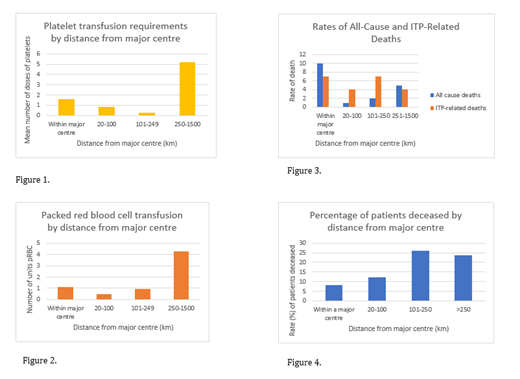Abstract
INTRODUCTION
Immune thrombocytopenia (ITP) is a hematological disease characterized by immune-mediated destruction of platelets. Prior to starting therapy for ITP it is critical to determine whether it is idiopathic or related to a secondary underlying condition as this informs treatment. There is significant use of blood products and components in patients with chronic ITP for management of thrombocytopenia and bleeding, including intravenous immune globulin (IVIg). Platelet transfusions are generally reserved for life-threatening bleeding or may be used in the preoperative setting in patients unresponsive to other therapies. The aims of this study are to identify gaps in process of care and to examine the impact of geographical remoteness on health service utilization and outcomes in adults with chronic ITP in Alberta.
METHODS
Adults who received rituximab, splenectomy, or thrombopoietin receptor agonists (TPO-RA) as second-line therapy for ITP during 2012-2019 in the province of Alberta, Canada were identified via the provincial special drug access database. Diagnostic workup including bone marrow biopsy results, abdominal imaging (ultrasound or CT scan), coagulation parameters, viral serologies for hepatitis, human immunodeficiency virus (HIV), serum protein electrophoresis (SPEP), and quantitative immunoglobulins were recorded and rates of completed tests were calculated. Utilization of IVIg, platelets, and packed red blood cells was assessed. Rates of hospitalization, mortality, and ITP-related deaths were calculated and compared according to geographic region.
RESULTS
Of the 204 patients identified for analysis 106 were female (52%). Most patients (123; 60%) lived within a major centre, whereas 21 (10%) lived over 250 km from a major centre. Review of diagnostic laboratory parameters revealed incomplete coagulation parameters in 117 patients (58%), and no coagulation parameters checked in 16%. Eighty-nine patients (44%) did not have quantitative immunoglobulins tested, and 57 (28%) did not have an SPEP performed. Fifty-three (26%) did not have any abdominal imaging performed to assess for splenomegaly or liver disease. Thirty-five (17%) did not have any viral serologies for hepatitis B, C, or HIV completed. Bone marrow aspirate and biopsy was performed in 110 patients (54%). Eighty-six (77%) of these biopsies yielded a normal result. Eight biopsies (7%) displayed a lymphoproliferative disorder or plasma cell disorder which was suspected or known prior to completing the test.
There was significant geographic discrepancy in utilization of blood products and hospitalizations. During 527 patient years of follow up, 83 patients received a total of 343 doses of platelets. Eleven patients (13%) received platelet transfusions for inappropriate indications, and eight (9%) for unclear indications. One hundred twenty-seven patients received IVIg (mean 1290 g) with comparable usage across geographic regions. Compared to patients within 250 km from a major centre, those with geographic remoteness (>250 km from a major centre) utilized more platelets (mean 5.2 vs 1.2 doses; Figure 1) and packed red blood cells (mean 4.3 vs 1.2 units; Figure 2). Those with geographic remoteness also experienced a higher rate of ITP-related hospitalizations (mean 1.5 vs 1.1) and deaths (24% versus 9%). At a median follow-up of 3.42 years from ITP diagnosis, 27 patients (13%) were deceased. Fourteen of these deaths were ITP-related due to bleeding or infection (52%). There appears to be a gradient of rates of both all-cause and ITP-related deaths by distance from a major centre (Figures 3 and 4).
DISCUSSION
This study highlights gaps in quality of care in patients with chronic ITP in Alberta, Canada. A significant number of patients have an incomplete workup for ITP at the time of diagnosis with the most forgotten tests being coagulation studies, SPEP, quantitative immunoglobulins, viral serologies, and abdominal imaging. Additionally, we identified an unexpectedly high rate of bone marrow biopsies performed in our population. Most of these bone marrow examinations did not result in any change in management. Finally, this study identified that geographic remoteness is associated with increased health services utilization and ITP-related deaths. These data can be used to inform further quality improvement initiatives in chronic ITP and help address geographic inequities in healthcare outcomes.
Sun: Bayer: Consultancy; Novo Nordisk: Consultancy; Pfizer: Consultancy; Shire: Consultancy; Octapharma: Consultancy, Research Funding.


This feature is available to Subscribers Only
Sign In or Create an Account Close Modal